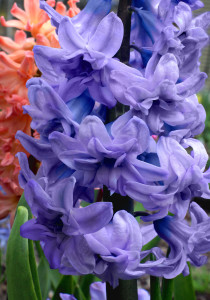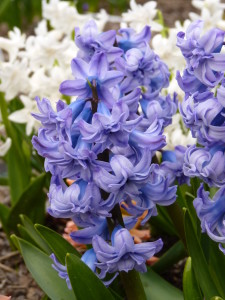
Somewhere out in my yard, General Köhler lies sleeping peacefully under a light blanket of snow. I expect he is snoring, or would be, if he were not a hyacinth bulb waiting for the earth to warm up next spring.
These days merchandisers frequently name plants according to purported ease of cultivation—“Oso Easy” and “Hasslefree” roses, are two good examples. Back before the Internet was around to warn us that most of our heroes’ had feet of clay, breeders and merchandisers named plants after worthy men and women. This tradition gave us ‘President Roosevelt’, a red peony, and ‘Sir Winston Churchill’, a daffodil. Douglas MacArthur, war hero, Medal of Honor winner and thorn in the side of President Harry Truman, may have died in 1964, but lives on as a pink rose.
‘General Köhler’, the hyacinth, was named in the spirit of ‘Douglas MacArthur’. Like MacArthur, General Johan Harmen Rudolf Köhler—1818-1873–was a military man. Unlike the twentieth century warrior, Köhler was not lucky enough to die peacefully in his own bed.
Köhler was born in the northern Dutch city of Groningen only three years after the Battle of Waterloo. Not much is known about his early years and education, but he was an officer, which, in those days invariably meant that he was a member of the Dutch upper class. He was in the infantry, which is sometimes a bit less prestigious than the more romantic cavalry, but Köhler excelled and eventually attained the rank of general. A surviving portrait shows a resolute-looking individual with an impressive head of white hair, a full mustache and a tiny goatee. He is wearing the Cross of the Dutch Military Order of William, which was given to individuals
who showed exemplary valor on the battlefield.
Köhler may have had abundant valor, but his luck ran out at the age of 55, when he led a military campaign at Aceh on the island of Sumatra in present-day Indonesia. The Dutch forces, protecting the European government’s interests in the area, were routed by an army of Acehnese. The Dutch troops were forced to retreat and their general was killed in the process. General Köhler was buried in a cemetery in Jakarta.

At the time of his death, Köhler was probably a hero in his homeland, which accounts for the fact that only five years later, in 1878, patriotic Dutch breeders introduced a beautiful double hyacinth named in his honor.
And what an honor it has proved to be. Double hyacinths have gone in and out of fashion since the first ones appeared in the late seventeenth century. By Köhler’s time, the doubles, with their lavish arrays of colorful petals, were all the rage. After a period of eclipse in the twentieth century, the opulent bloomers are making a comeback, with some of the mainstream vendors even offering a few new varieties.
The General’s hyacinth is medium blue-purple, with each petal striped down the center in a slightly darker shade. It has the divine, sweet smell characteristic of all hyacinths and in its first year after planting, the individual flowers are tightly crammed on the thick, upright stems. I generally take the advice of Scott Kunst, former owner of the Old House Gardens nursery, and insert a short stake right next to each plant. No tying is necessary, but the stake allows the ‘General\ to stand at attention with no risk of sagging due to fatigue, top-heaviness or inclement weather.
Hyacinth flowers tend to be more loosely clustered when they bloom in the second or third season after planting. This is also true of ‘General Köhler’ and other doubles. I don’t mind this, but if you are adamant about hyacinths looking the same year after year, you can treat them like annuals, lifting and discarding the bulbs after they bloom and planting new ones every year.
Like most spring-flowering bulbs, hyacinths like a sunny, well-drained site. They will also do nicely under deciduous trees, because the hyacinths bloom before the trees are fully leafed-out. Plant them towards the fronts of borders or in containers. Since fragrance is one of hyacinth’s greatest attractions, group the plants near walkways, patios and other places that people gather.
The original General Köhler was a hero who died in a retreat. Perhaps his memory is redeemed by the fact that his Dutch-bred namesake, the ‘General Köhler’ hyacinth, manages to defeat the forces of winter, returning every year to conquer the spring garden.
It is too late this year to enlist the ‘General’ for your garden, but make a note wherever you put ideas for next year. You can obtain the bulbs from Old House Gardens, 4175 Whitmore Lake Rd., Ann Arbor, MI 48105; (734) 995-1486; www.oldhousegardens.com. Print catalog $2.00.
